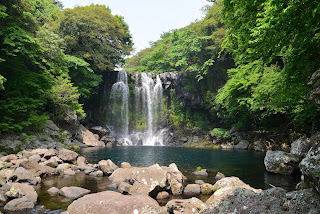I got asked this question last night. For starters, this
question actually peeved me. Not the question itself, but the conversation that
led up to the question.
I was at a dinner, welcoming incoming students to Korea University,
where I started asking the age old question, “Why did you come to Korea?” Some
replied it’s because they have family here, some said just to see, but the
overwhelming majority said “K-pop”. There was no other reason for them to be in
Korea. The sole reason they came was for the cookie cutter K-pop world.
The restaurant we went to happened to have music videos
playing in the background. Anytime a K-pop band appeared on the screen, the
large table of 20 went silent to intently stare at the screen filled with
gorgeous boys or girls, occasionally letting out screams when their favorite
idol did “idol things”. This left the remaining few of us in awkward silence while
we watched these girls salivate over a TV screen.
When the question came back to me, asking why I came to
Korea, they first asked if I was part Korean. I am not. Then they asked if I
liked K-pop. I do not. Then they all looked at me perplexed. “Then why did you
come to Korea?”
The question, when asked in such a way completely dumbfounded
me. Why do people like to go to France, or Spain, or Australia? Are they going
simply because they are obsessed with the pop culture there? What reason is
there to go to another country other than for pop culture or family?
I took a moment to gather my thoughts before simply
replying, “Just because.” I did come to Korea “just because.” When looking to
study abroad, Korea wasn’t even on my map. I knew of North Korea, I knew my
grandfather fought in the Korean War, and I butchered the pronunciation of
Seoul. However, when asking about going to a different country, the man at the study
abroad booth said, “Hey, what about Korea instead?” He then proceeded to tell
the story of how he wound up in Korea. He didn’t choose it, as a matter of
fact, he wanted to go to China, but he didn’t get accepted so it was suggested
to him that he go to Korea instead. So he did. And he loved it. The story he
told me was a story filled with love and passion. I thought to myself, maybe I
can love Korea, too.
When the time came for me to actually study abroad, Korea
was on my list, but it was not my first choice. Rather, I wanted to go to
Japan. However, in a twist of fate, I
couldn’t go to Japan and had to “settle” for Korea. I’m not going to lie; I
wasn’t excited about this at first. I really, truly wanted to go to Japan. I
had been fascinated with Japan ever since I was a little kid, from the history
to the culture to the fashion. I wanted to experience Japanese culture, not
Korean.
Something my mother taught me was to always look on the
bright side. Even if a situation is grim, there is one shimmer of light. So I
went to Korea, knowing nothing about the language and culture, I made the
decision that I must look on the bright side, and since I loved Japanese
history and culture so much, why not give that same chance to Korea?
I have never regretted giving Korea that chance.
I didn’t come here for family or K-pop, I came here for the
same reasons so many students study abroad every year—I want to experience and
learn a different culture, and I have loved every minute of doing so.


















































